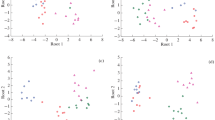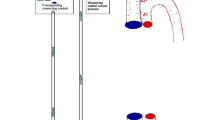Abstract
A possible relationship between the changes in the properties of S2-receptor binding sites and the turnover rate of 5-hydroxytryptamine (5-HT) has been investigated in cerebral ischemia associated with either little or marked edema. Bilateral common carotid artery occlusion for 5 or 15 min with 1 hour of reestablished blood flow in gerbils served as a model for the respective studies. An alteration in kinetic characteristics of S2-receptor binding sites labeled with [3H]ketanserin (the potent 5-HT antagonist for postsynaptic receptors) was detected in the synaptosomes separated from brains of gerbils subjected to 1 hour release after 15 but not following 5 min of bilateral ischemia. At the same time, an increased turnover rate of 5-HT was found in the cerebro-cortical homogenate. The duration of ischemic insult which leads to the changes in the properties of S2-binding sites and the increase in turnover rate of 5-HT has been identical with that needed for the marked accumulation of water in the gerbil brain reported previously. Thus, these findings are consistent with the implicated involvement of 5-HT in the formation of ischemic cerebral edema.
Similar content being viewed by others
References
Abe, K., Abe, T., Klatzo, I., and Spatz, M. 1980. Advances in Neurology. Effect of endogenous central nervous system depressants in ischemic cerebral edema of gerbils. Pages 429–441,in Cervos-Navarro, J., and Ferszt, R. (eds.), Advances in Neurology, Vol. 28: Brain Edema, Raven Press, New York.
Bhakoo, K. K., Crockard, H. A., Lascelles, P. C., Path, F. R. C. and Avery, S. F. 1984. Prostaglandin synthesis and oedema formation during reperfusion following experimental brain ischemia in the gerbil. Stroke. 15:891–895.
Both, R. F. and Clark, J. B. 1978. A rapid method for the preparation of relatively pure metabolically competent synaptosomes from rat brain. Biochem. J. 176:365–370.
Conn, P. J., and Sanders-Bush, E. 1985. Serotonin-stimulated phosphoinsitide turnover: mediation by the S2 binding site in rat cerebral cortex but not in subcortical regions. J. Pharm. Exper. Therap. 234:195–203.
Djuricic, B. M., Micic, D. V., and Mrsulja, B. B. 1984. Phasic recognition of edema caused by ischemia. Pages 491–498,in Go, K. G., and Baethmann, A. (eds.), Recent progress in the study and therapy of brain edema. Plenum Press, New York, London.
Iyengar, R., and Birnbaumen, L. 1981. Agonist-specific desensitization: molecular locus and possible mechanisms. Pages 93–99,in Dumon, J. B., Greengard, P., and Robinson, G. A. (eds.), Advances in cyclic nucleotide research 14. Raven Press, New York.
Knott, G. D. 1979. Lab-a mathematical modeling tool. Comp. Prog. Biomed. 10:271–280.
Laverty, R., and Taylor, K. M. 1968. The fluorimetric assay of catecholamines and related compounds: improvement and extensions to the hydroxyindole technique. Analyt. Biochem. 22:269–279.
Leysen, J. E., Neimegeers, C. J. E., Van Neuten, J. M., and Laduron, P. M. 1981. [3H]Ketanserin (R441 468), a selective3H-ligand for serotonin receptor binding sites. Binding properties, brain distribution and functional role. Mol. Pharmac. 21:301–314.
Lowry, O. H., Rosenbrough, N. J., Farr, A. L., and Randall, J. R. 1951. Protein measurement with folin phenol reagent. J. Biol. Chem. 193:265–275.
Neff, N. H., and Costa, E. 1966. The influence of monoamine oxidase inhibition on catecholamine synthesis. Life Sci. 5:951–957.
Maruki, C., Merkel, N., Rausch, W. D., and Spatz, M. 1984. Pages 673–681,in Go, K. G., and Baethmann, A. (eds.), Recent progress in the study and therapy of brain edema, Plenum Press, New York, London.
Mrsulja, B. B., Mrsuja, B. J., Spatz, M., and Klatzo, I. 1976. Monoamines in cerebral ischemia in relation to brain edema. Pages 187–192,in Pappius, H., and Feindel, W. (eds.), Dynamics of Brain Edema, Springer, Berlin, Heidelberg, New York.
Mrsulja, B. B., Djuricic, B. M., Cvejic, V., Mrsulja, B. J., Abe, K., Spatz, M., and Klatzo, I. 1980. Biochemistry of experimental ischemic brain edema. Pages 217–230,in Cervos-Navarro, J., and Ferszt, R. (eds.), Advances in Neurology, Vol. 28, Raven Press, New York.
Mrsulja, B. B., Micic, D. V., and Djuricic, B. M. 1983. Gerbil stroke model: an approach to the study of therapeutic aspects of postischemic brain edema. Pages 45–60,in Stefanovich, V. (ed.), Advances in the Biosciences. Vol. 43. Stroke: Animal Models, Pergamon Press, Oxford, New York, Toronto, Sydney, Paris, Frankfurt.
Mrsulja, B. B., Djuricic, B. M., Cvejic, V., Micic, D. V. 1984. Pharmacological approach to postischemic brain edema in gerbils. Pages 683–689,in Go, K. G. and Baethmann, A. (eds.), Recent progress in the study and therapy of brain edema. Plenum Press, New York, London.
Mrsulja, B. B., Djuricic, B. M., Ueki, Y., Cahn, R., Cvejic, V., Martinez, H., Micic, D. V., Stojanovic, T., and Spatz, M. 1985. Cerebral blood flow energy utilization, serotonin metabolism, (Na,K) ATPase activity and postischemic brain swelling. Pages 170–177,in Inaba, Y., Klatzo, I., and Spatz, M. (eds.), Brain Edema, Proc. Sixth International Symposium, November 7–10, Tokyo. Springer Verlag, Berlin, Heidelberg, New York, Tokyo.
Scatchard, G. 1949. The attraction of proteins for small molecules and ions. Ann. NY Acad. Sci. 51:660–672.
Welch, K. M. A., Chabi, E., Dodson, R. F., Wang, T. P. F., Nell, J., and Bergin, B. 1976. The role of biogenic amines in the progression of cerebral ischemia and edema. Pages 193–202,in Pappius, H., and Feindel, W. (eds.), Dynamics of brain edema. Springer, Berlin, Heidelberg, New York.
Wroblewska, B., Ueki, T., Mrsulja, B. B., Djuricic, B. M., and Spatz, M. 1985. Serotonin (S2)-receptors in ischemic brain edema. Pages 178–184,in Inaba, Y., Klatzo, I., and Spatz, M. (eds.), Brain Edema, Proc. Sixth International Symposium, November 7–10, Tokyo. Springer Verlag, Berlin, Heidelberg, New York, Tokyo.
Author information
Authors and Affiliations
Rights and permissions
About this article
Cite this article
Wroblewska, B., Kumami, K., Cvejic, V. et al. Cerebrocortical modulation of S2-receptors and turnover rate of 5-hydroxytryptamine in ischemia. Neurochem Res 12, 21–25 (1987). https://doi.org/10.1007/BF00971359
Accepted:
Issue Date:
DOI: https://doi.org/10.1007/BF00971359




